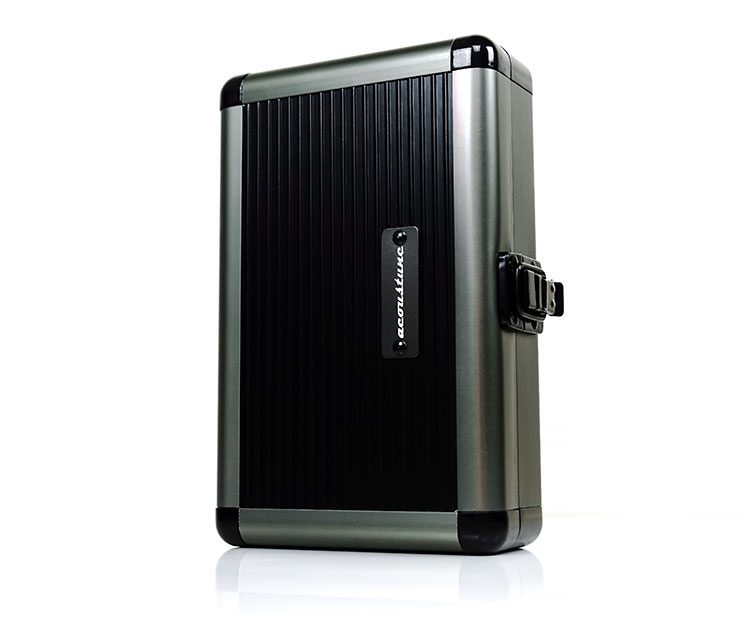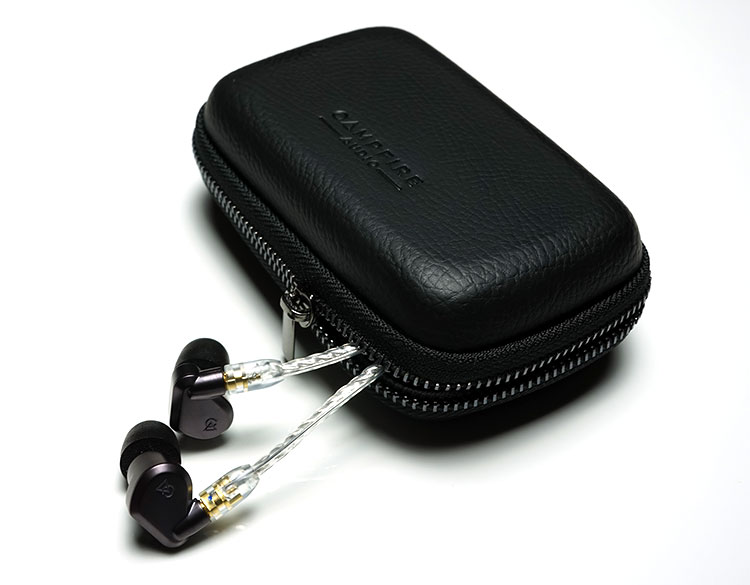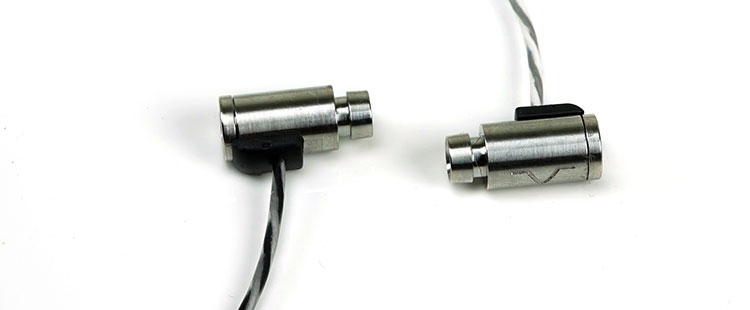Sound Impressions
Tonality & Presentation
The HS1551 CU delivers a mildly u-shaped response with a fair degree of tonal warmth and an invitingly rich instrumental timbre that simply flows.
Those coming in from something like the Andromeda will recognize that engaging low-to-mid-range performance though the top-end is where they diverge with the Andromeda delivering a much cleaner and brighter treble. The HS1551 CU instead ops for a much more relaxed top-end with just enough sparkle and air to prevent the HS1551 CU from sounding dark or veiled.
It is also a classic dynamic driver sound which means a very strong emphasis on a deep and spacious sounding low-end though not as physical sounding as Campfire Audio’s Vega but every bit as natural sounding. Being a classic DD you will get a slightly slower more languid pace with a bit more decay but it has this wonderfully textured full-bodied response that you simply cannot get with BA designs.
The emphasis here is one of very musical, easy, and non-fatiguing presentation that is very likable. Those who love a neutral and clean signature with a heavy emphasis on intricate articulation or a very neutral accurate timbre, well this is not for you.
Staging
The staging on the HS1551 CU is deep and wide and fairly spacious sounding. There is a little edge off the top that rolls down progressively so you will not find it as airy as some dynamic drivers such as the IE800. It does avoid sounding dark with some minor bumps around the 7k and 12k marker keeping things reasonably well extended but the focus here is more low to mids.
Bass
The bass on the HS1551 CU is not as heavy-hitting as the Vega yet it does convey a very full-sound with an impactful response. The lack of intense physicality is really the main differentiator between it and the CA behemoth.
The response curve on the HS1551 CU low-end peaks more around 80-100Hz and tails off ever slightly below that. Rumble is good but it is not the driving factor in the HS1551 CU’s bass signature. Instead, it is about warmth with impact and reasonable levels of rumble compared to say the Vega’s much higher level of sub-bass and dominating levels of power.
Some might find its lack of physicality a bit soft or it lacks BA levels of tightness but the trade-off is that rich and wonderful texture.
Mids
The HS1551 CU also successfully avoids sounding muddy or boomy with a nice gentle dip into the lower mids post-100Hz. The dip is not enough to cool off the sound or thin out instrumental notes so it does carry a healthy level of warmth up with it.
As a result, instrumental timbre is even harmonic dominant with a rich and very liquid tone. I would not go quite as far as saying its an overly romantic midrange tone, nothing smeary or lacking in detail but it certainly has an easy euphonic flow about it.
Vocals are also very sweet and rich sounding with a slightly better emphasis on higher-pitched vocals north of 1k where the energy on the HS1551 CU starts to pick up.
Both male and female vocals have next to no sibilance. However, the generally relaxed mid-range tone might have some want just a shade more upper harmonic emphasis or an “edge”. Depends on your mood but I do suggest pairing with a neutral source. Something like an AK240 DAP sounds perfect with the HS1551 CU vocals performance.
Treble
There is a fairly substantial drop on the HS1551 CU from 2-5k which takes a little edge off some upper-mids percussion timbre so for some this might sound a touch undercooked with vocals to the fore and percussion sitting passively behind. That doesn’t mean its unnatural sounding but it is a little muted in deference to vocal performances.
The HS1551 Cu pulls most of its treble energy from a 5-7k peak and a little air from a smaller 10-12k peak. Neither peaks are hugely elevated, just enough to deliver a bit of energy and sparkle and some welcome contrast to the very smooth sound of the bass and mids. Nothing worse than a smooth but veiled sound and the HS1551 CU just avoids that.
It is however not the airiest of signatures and delivers a fairly laid back and inoffensive top-end. The detail is there, it is just not in your face.
Matchability
Efficiency & Scaling
The HS1551 CU is rated at 32Ω and 110dB. I actually think that’s a pretty ideal rating and one of the best I have seen for a single DD in terms of sensitivity ratings.
It is sensitive enough to get loud enough fast enough on smartphones and still sound good. At the same time, additional amping power will mean it can scale and sound even better. That, combined with its euphonic tone, should pair very well indeed with a wide range of sources at the consumer and audiophile level.
My own personal recommendation is to stick to a well-powered DAP such as the DX200 with AMP1 or a solid-state portable amp such as the RHA L1 or the ALO Audio RX. You can get away with a FiiO A5 also but I find it is not as refined in the upper mids as the mid-fi portable amps and DAPs.
IEM Efficiency Comparisons
If you are coming from the IE800 single DD you will not have to adjust much for volume and power with both almost on the same level from similar sources such as a Sony 1Z, DX150, and a HiBy R3.
Those considering one of the Campfire Audio single dynamic driver IEMs might be interested to know that the Vega and Lyra II are much less sensitive despite their lower impedance ratings of 17Ω each. In both cases, they need a few dB more volume to get equivalent levels of loudness. For the Lyra II, an additional level of power is not really required. If using the Vega then it does need much more power than the HS1551 Cu to sound optimal.
The similar priced single DD Flares Pro does not have an official spec sheet but I can tell you it is less sensitive than the HD1551 Cu, requiring a bit more volume and also a lot more power to sound optimal. I would hazard a guess and estimate it at 104dB or less.
Noise
None whatsoever but I have always found solid dynamic driver IEMs to be fairly noise resistant. Generally, they are not as sensitive as balanced armature designs. In the case of the HS1551 CU, all the usual suspects are dead silent such as the FiiO X3iii, ALo Audio V5, and the Shozy Alien.
Select Comparisons
Sennheiser IE800
$599
Technical
The IE800 is rated at 16Ω and 116dB and one of the easier single dynamic driver IEMs out there. Both it and the HS1551 Cu run about the same level as each other across a wide variety of sources. Perhaps the CU has a slight edge but not by a huge amount.
Build wise, despite the quirks of the HS1551 CU and it ‘so-so’ seal it is still miles ahead of the IE800 in terms of comfort and isolation. I could never get overjoyed using the IE800’s short non-detachable wire-thin cable. The proprietary tip system is also a PITA to use compared to the generic foam and silicone tips of the HS1551 CU.
Performance
Again, both have a musical lilt however the IE800’s smaller driver really paints a much lighter almost ethereal quality. There is more energy in the top-end, a midrange that is more recessed and a low-end that is politer.
The IE800 is detailed though and its articulation is excellent whereas the HS1551 CU delivers much better body, more low-end impact, and better vocal body. It also is not as brittle in its lower mids making it much more suitable for daily grinder rock and pop. The IE800 comes into its own for classical scores where that airy top-end and better headroom is required.
Campfire Audio Lyra II
$699
Technical
The Lyra II is a single dynamic driver universal rated at 17Ω and 102dB. It does require a bit more gain than the HS1551 CU, around 2-3dB minimum on a good DAPs such as the DX150 or Sony 1Z. However, its power rating is such it will not scale quite as well as the HS1551 CU and it didn’t change a huge amount with better amping. That being said smartphones are not the fourte of the Lyra II, get yourself a resolving neutral DAP.
Build wise I have to favor the finish and fit of the Lyra II over the HS1551 CU. It is smaller, lighter, very durable, and fits in with a better level of comfort and seal. Both use detachable MMCX systems and both have a good stock wire with the Lyra II favoring a silver Litz over the 4-core OFC of the HS115 CU.
Performance
Both have a u-shaped and musical tonal presentation. However, the Lyra is just a little lighter and not quite as warm sounding as the HS1551 CU. The Cu has a much richer low-end and mids with more body, low-end bass texture, and slightly more aggressive sounding.
The Lyra still has a reasonably euphonic tone and natural timbre but it is not quite as rich opting instead for more mids and treble energy. As a result, the Lyra has more of a harmonic balance and definitely more snap in its percussive attacks. You will get a better perception of detail with the Lyra II but that bigger driver of the HS1551 Cu is fuller and more spacious sounding.
Flare Audio Flares Pro
$499
Technical
Flares Pro do not have officially published specs but my guess is they are less sensitive with a fairly medium load of about 20-30Ω. For sure its nowhere near 110dB SPL and closer to 102-104dB. For power, it ranks up there with the Vega in terms of just sucking it up and has no issues being driven by a desktop amp.
The HS1551 CU is easier to drive and gets louder quicker than the Flares Pro though it can still scale pretty well with portable amps. Noise performance is stellar on both.
Build wise the Flares Pro is a much smaller, lighter bullet type construction and has the unique advantage of also being a BT IEM which is the key seller for me. The HS1551 CU is bulkier but has an advantage in the tip selection.
The Flares Pro sound optimal with these very breakable audiophile foam tips that cost a fortune to replace. They do not sound as good either with the standard supplied tips. The HS1551 CU has no such issues with the supplied tips.
Performance
The Flares Pro delivers a more neutral and linear type performance with a clean and clear tonality. It has more emphasis on detail and articulation though the low-end is not quite dead flat. There is a sliver of warmth but not a huge amount, just enough to keep it from sounding too dry and thin sounding. It is a pacier low-end, much more so than the HS1551 CU. The CU has the better slam, the greater warmth and is the fuller sounding of the two.
Mids on the Flares Pro are more neutrals in terms of positioning with great articulation and an accurate instrumental timbre. The CU has a more euphonic instrumental timbre, better body, and a fuller more forward sounding vocal presence.
The top-end on the Flares Pro is cleaner, more extended and airier but it is also thinner and harder sounding with a bit more sibilance creeping into the upper mids and lower treble. The Cu is more laid back with slightly less air and a little more muted in the upper mids.
Our Verdict
To be honest I find the HS1551 CU to be a far more engaging and likable dynamic driver IEM than the IE800. It has a warm and rich tone to it with an expansive open sounding presentation and more than a decent low-end impact. There is nothing sharp, brash or smoother over either.
It has got that natural sound I enjoy from a dynamic driver but never in your face or as physical as the more expensive Vega. It is tuned to be resolving yet relaxed and easy-going. Whilst it will run just fine on a smartphone I think it really comes alive with a quality DAP with some power or a small portable solid-state amp.
At $450 the price is just right and you can tell Acoustune made a considerable effort in styling and packaging to ensure the HS1551 CU looked the business. I have my fit issues, your mileage may vary on that one but it is a rock-solid build with a great stock cable. At a time when single BA IEMs around $200-400 are gaining in popularity, I think the HS1551 CU makes a very good case indeed for single DD alternatives.
Acoustune HS1551 CU Specifications
- Transducer: Φ10mm Single Dynamic Driver
- Impedance: 32Ω
- Sound Pressure Level: 110dB/mW
- Frequency Range: 10Hz~25KHz
- Cable: MMCX Re-cable, L=1.2m (4-core)
- Plug: Φ3.5mm plug (gold plated), L-type
- Shell: Chamber – 100% Brass CNC milling, Housing – 100% Aluminum CNC milling
- Color: Grand Blue & Gold / Burgundy & Gold
- Accessories: Earphone, Cable, Ear-tips (4 types)*, Earphone Case, Cable Clip & Tie, Warranty, Safety Instructions
- * Ear-tips: AET02 (F), AET06 (M+), AET07 (S/M/L), AET08 (S/M/L)








